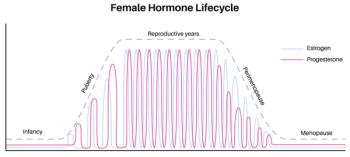
Pigmented lesion on an elderly man's lip
An 89-year-old hemiplegic man is seen for a routine physical examination. Major right brain stroke produced permanent dense left-sided motor deficit years ago. Has related vascular dementia.
This article was originally presented as an independent educational activity under the direction of CME LLC. The ability to receive CME credits has expired. The article is now presented here for your reference. CME LLC is no longer responsible for the presentation of the article.
The Case
An 89-year-old hemiplegic man is seen for a routine physical examination. Major right brain stroke produced permanent dense left-sided motor deficit years ago. Has related vascular dementia. Completed full isoniazid prophylaxis for newly positive PPD skin test 2 years back; underwent concomitant pyridoxine repletion. Has benign prostatic hyperplasia, urolithiasis, and esophageal reflux disease. Takes 14 medications, including warfarin, sotalol, tamsulosin, tizanidine for spasticity in the left hand, and quetiapine.
More History/Physical
Man whose smile is evident and winning, notwithstanding left central facial palsy. Scabbed 1 cm basal cell carcinoma on right temple (neither he nor family wants it treated). Left hemiplegia. Flexion contracture at wrist, with padding and splint to prevent injury and retard progression. Verbal output sparse but mostly appropriate. Mouth as shown. Dentition and gums unremarkable for age.
Laboratory Findings
INR, 2.8 (target therapeutic range for this patient, 2 to 3).
What's Your Diagnosis?
•
•
•
•
•
•
The correct diagnosis is Venus Lake of the Lip
A mass disfigures the left upper lip near the corner of the mouth. This mass, which is not ulcerated and appears to lie below the lip mucosa/skin, looks as though it would feel soft, and on palpation it did. A dark blue, almost black hue is attenuated by the intervening epithelium. The color is confined to the center of the mass, most prominently just beneath the vermilion border. This lesion is a venous lake, an innocuous dilatation of surface vein(s) found on the lips and ears of aged persons.1-8 The remainder of the lip area appears healthy.
The cheek and uppermost philtrum look pinker than normal and a bit telangiectatic; these findings are consistent with solar injury. Tiny excoriations dot the anterior neck at the bottom of the photograph but are unrelated to the venous lake. The chin sports minute shaving cuts, one almost healed. Perioral skin appears normal.
Numerous Possibilities
A highly gratifying feature of physical diagnosis is the confidence that a lesion does not warrant referral or biopsy to rule out troublesome or ominous look-alikes: I did not call the dermatologist to corroborate that this was neither a nevus nor the beginning of a malignant melanoma. I did not call a dentist to exclude lip cancer or a hepatologist to confirm what I already knew-that this was not a spider angioma1 and that there was no evidence of occult cirrhosis. Nor did I call on a gastroenterologist to consider conditions whose cutaneous manifestations suggest a particular cause of GI bleeding.1
Case Discussion
Because the patient had a basal cell carcinoma on the face, one could suspect that this new lesion was of the same type. But this is the "wrong" surface for solar injury, including cancer: the up-facing lower lip is much more prone to squamous cell carcinoma. If the face and back of the neck were cross-hatched with solar elastosis or the face were full of keratoses that suggested exceptional heliodermatosis (sun-damaged skin), one might worry more, but this man's skin looks good overall. Nor is the lesional epithelium thickened or crossed by telangiectases. The lack of ulceration provides less reassurance, since early basal cell carcinoma may have an apparently unbroken skin surface.
A third group of differential diagnoses includes pigmented lip lesions such as are found in patients with Addison disease and Peutz-Jeghers syndrome.3 The large and solitary nature of this mass renders such a prospect unlikely, even before one has noted that its slate-blue color differs markedly from the brown expected in those conditions. The color might lead us to consider lead poisoning (although the blue line associated with this condition runs on the gingiva9), argyria,10 or even mino-cycline pigmentation.11 However, the locale is wrong for all of those. Moreover, in these conditions, the color arises from something other than contained venous blood that is relatively static.
Perhaps the most realistic differential diagnosis is mucocele, but these lesions should not blanch with pressure, whereas venous lake does so.3 Furthermore, one can at times observe the mucoid character of the material within a mucocele and feel concomitant fluctuance on palpation.
Bedside Recognition
If the diagnosis is in doubt, the application of pressure should reduce or empty a venous lake because the contained blood is only seldom thrombosed,2 and it is not confined by small tortuous channels. The lesion can be pressed with a finger or a transparent glass slide or plastic lens. The glass slide application constitutes an old but useful technique, diascopy.
Softness and elevation do not fit with an ecchymosis or a hematoma, nor is there surface injury that might have been inflicted at the same time. A magenta tinge, or evolution into the expected sequence of yellow brown and greenish brown, would support extravasation of blood as the cause of discoloration. Substantial blanching on pressure would exclude extravasation: once outside the vessels, blood cells cannot move with any speed in the stroma of skin or subcutis, although slow gravitational settling is a familiar element in the changing shape of bruises and postoperative ecchymoses that are observed closely over a period of days.
The association of venous lakes with aging is consistent with exacerbation by solar injury; that the lower lip is more commonly affected2 accords with this. But this patient's lesion arose on sparse background dermopathy, and on the upper lip, which underscores how incompletely we understand venous lake, 50 years after the first report.
Whether lips or ears are more often affected by venous lake depends on which series one studies. Only two papers describe tenderness5,7; others report none. Our patient did not have tenderness, nor was there a sensory hemideficit or a proximal neuropathy that might have obscured this sign.
Dr Bean and Modern Bedside Diagnosis
Considering that venous lakes sit squarely in view on the face and do not resemble any other common lesion of the aged, it is extraordinary that they were not described in print until the middle of the 20th century. A wonderful book written just 2 years afterwards by their describer, Dr William Bennett Bean,1 conveys innumerable astute observations and inferences about these lesions and many others.
Any reader of this classic textbook who has an interest in bedside diagnosis will feel humbled and enriched in equal measure; this arises partly from the meticulous and precise descriptions: "The color is dark bluish, almost black at the center, and sometimes fading into claret red at the edge... the purplish blue color is given to the lesion by the large accumulation of venous blood... variation in quality and depth of color occurs... in parts of the same [lesion]. Unevenness in thickness of endothelium and the thin layer of overlying skin and the depth of the accumulated blood account for this variability."1
Equally, one is struck by the close analysis: "They cause no symptoms unless traumatized. Those on the face may be nicked in shaving... they bleed with nasty persistence, since they are little and have none of the self-sealing mechanism of sticky vasoconstriction available in such high perfection in the small vessels of normal skin and of the interior of the body."
Finally, there is wonderful and clear-sighted impatience about "the tragic longevity of error" in that a surface lesion once erroneously believed to mark internal cancer retains the label regardless of how much scientific evidence is presented to the contrary. This facet stunningly prefigures those medical "reports" on the Web, simplistic summaries-of-summaries of original research that are quoted eagerly to physicians by a patient or family-often in the setting of incurable disease-and often with heartbreaking faith that their exaggerated conclusions are justified, and with no understanding that they are utterly lacking in merit and credibility.
Multiple Therapeutic Options
Venous lakes pose no problem other than cosmetic. Diverse remedies have employed numerous kinds of radiant energy.4,5,7,8 "After" photographs in the reports show complete resolution and an admirable lack of scarring. These modalities augment the old technique of injecting a sclerosant into a varicose vein that is now also used for venous lakes,6 and surgical ablation, the old standard,2 which is effective but is more invasive and requires at least local anesthesia.
References:
References:1. Bean WB. Vascular Spiders and Related Lesions of the Skin. Springfield, Ill: Charles C. Thomas; 1958:3-110, 240, 249-255, 292-295, 306.
2. Bu J, Shi H, Hu M, Liu H. Oral venous lakes: a clinicopathologic analysis of 20 cases [in Chinese]. Zhonghua Kou Qiang Yi Xue Za Zhi. 2002;37:33-35.
3. Wood NK, Goaz PW. Differential Diagnosis of Oral and Maxillofacial Lesions. 5th ed. St Louis: Mosby; 1997:566-569.
4. Neumann RA, Knobler RM. Venous lakes (Bean-Walsh) of the lips--treatment experience with the argon laser and 18 months follow-up. Clin Exp Dermatol. 1990;15:115-118.
5. Jay H, Borek C. Treatment of a venous-lake angioma with intense pulsed light. Lancet. 1998;351:112.
6. Kuo HW, Yang CH. Venous lake of the lip treated with a sclerosing agent: report of two cases. Dermatol Surg. 2003;29:425-428.
7. Majamaa H, Hjerppe M. Treatment of venous-lake angiomas with a carbon dioxide laser. J Eur Acad Dermatol Venereol. 2003;17:352-353.
8. Ah-Weng A, Natarajan S, Velangi S, et al. Venous lakes of the vermillion lip treated by infrared coagulation. Br J Oral Maxillofac Surg. 2004;42:251-253.
9. Schneiderman H. Lead poisoning. Consultant. 1993;33(1):97-99.
10. Schneiderman H, Iloeje VA. Argyria: an innocent finding misinterpreted as life-threatening cyanosis. Consultant. 2001;41:266-272.
11. Schneiderman H, Chapron D, McMahon E. Minocycline-induced blue-black pigmentation of the skin: a cosmetic problem that causes intense embarrassment. Consultant. 2004;44:817-826.
Newsletter
Enhance your clinical practice with the Patient Care newsletter, offering the latest evidence-based guidelines, diagnostic insights, and treatment strategies for primary care physicians.

























































































































































































































































































